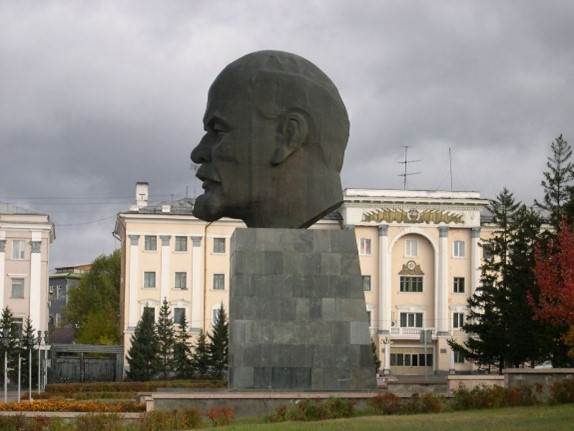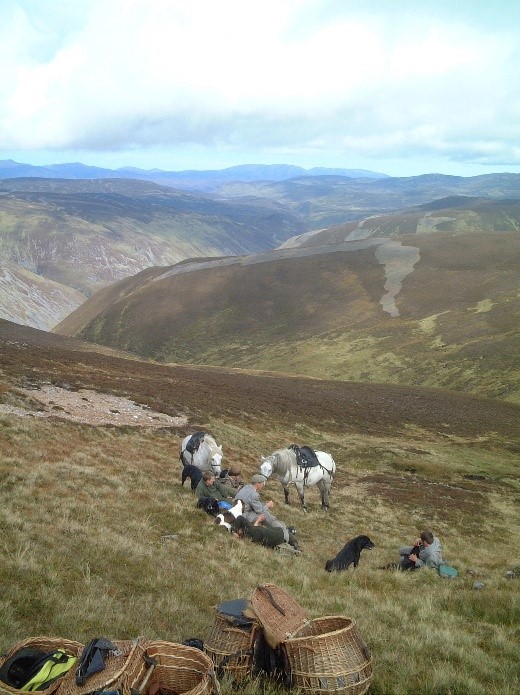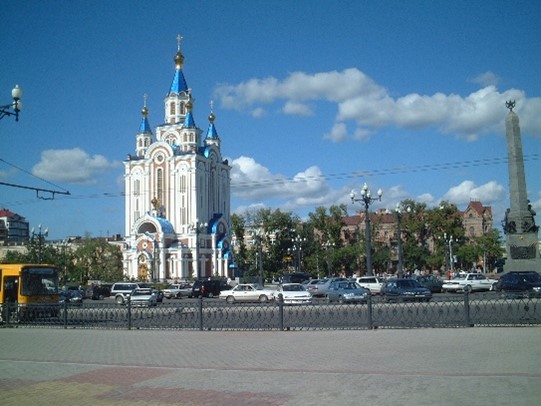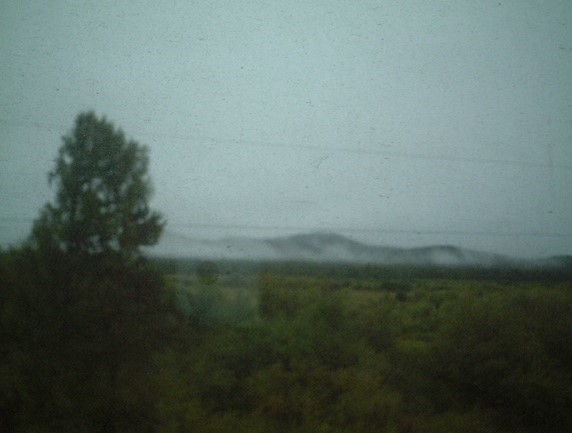
16 Jul From Khabarovsk to St Petersburg on the Trans-Siberian Railway Part 1 of 4
Khabarovsk
In September 2003, as I was busily settling into the bosom of retirement in Australia, I was invited to a week’s deer stalking and fly fishing on the Athol Estate in the Scottish Highlands. It wouldn’t be just a week of shooting and fishing but an opportunity to catch up with English friends in one of Scotland’s most famous lodges. Folklore has it Victoria spent a night in Forest Lodge with her servant, John Brown, during their walk across the Highlands from Balmoral to Blair Athol in October 1861. In the event the sport and the lodge exceeded all expectations so I was delighted to receive Bill Ferguson’s invitation to return in the autumn of 2004.
With time on my hands, I began thinking about ways to travel to Scotland other than getting on QF001 and flying direct. Perhaps a slow boat to San Francisco, the California Zephyr east to New York and an Atlantic clipper to Southampton. Tempting but impractical. The answer was to fly to Vladivostok, via Seoul, take the Trans-Siberian to St Petersburg and fly from there to London. It was a good plan until I arrived at Brisbane Airport on a Monday night for an 8.35 pm departure. There were no details for a Seoul flight on the departures screen; something was wrong. My ticket told the story – it was an 8.35 am departure. Fortunately, I had booked everything through Flight Centre, and first thing Tuesday morning they found a way to get me to Khabarovsk, to the west of Vladivostok, in time to catch my train from there. Fileas Fogg would have been proud.
My Asiana flight from Incheon took a wide detour out into the Sea of Japan to avoid North Korea before turning on to a northwest approach into Khabarovsk. Between the coast and our destination, we flew over three military airfields. I wondered if any had been involved in the KE007 atrocity in which 269 passengers on a flight from New York to Seoul had been shot down near here twenty years earlier for being 200 miles off course.

The Trans-Siberian leg of my journey had been booked as a two week tour including homestay accommodation for stopovers in Khabarovsk, Irkutsk and Moscow. Khabarovsk immigration formalities were surprisingly brief and Anna, the breezy courier, was there to meet me so the tour was back on track. Our first port of call was the tenement block that was to be my homestay. Some home. My hostess, Emma, although nice, could hardly walk and spoke English as well as I spoke Russian and my bedroom was snug.
Anna walked me to the town square and left me to do battle with an ATM, which eventually coughed up some roubles. Cashed up, I took a walk down Muraviev-Amursky Street to the great Amur River. For much of its 3,254 kilometres it provides a convenient border with China. However, from Khabarovsk, river and border part company and the river heads north-east to empty into the Sea of Okhotsk, opposite the northern end of Sakhalin Island.

Nikolay Muraviev-Amursky (1809–1881) was a Russian statesman and diplomat who played a pivotal role in Russia’s nineteenth-century expansion into the Far East. As governor-general of Eastern Siberia from 1847, Muraviev pursued an assertive strategy to secure control over the Amur River basin. Through exploration, military presence and the establishment of settlements, he laid the groundwork for a dramatic shift in the Sino-Russian frontier.
His efforts culminated in the Treaty of Aigun (1858) and the Treaty of Peking (1860), both of which transferred vast territories from Qing China to the Russian Empire. These treaties effectively overturned the earlier Treaty of Nerchinsk (1689)—a landmark agreement that had, for the first time, defined the border between the two empires. Negotiated on relatively equal terms, Nerchinsk had placed the Amur region firmly within the Qing sphere of influence, while granting Russia trading rights with Beijing.
By contrast, the later treaties were signed at a time when China was militarily weakened by internal rebellions and Western imperial pressure, particularly following the Second Opium War. China has since contended that the Treaty of Aigun was extracted under duress, reflecting unequal power dynamics rather than mutual consent. From this perspective, Muraviev-Amursky’s diplomatic triumph is also seen as part of the broader pattern of nineteenth-century ‘unequal treaties’ that compromised China’s territorial integrity.
I learnt much of this from Colin Thubron’s In Siberia which I had bought in Sydney airport as a guidebook. But there was a slight problem – his narrative ran from west to east so I had to read the book from back to front but it’s well indexed so the problem was manageable.
It was a warm sunny day so there was no shortage of pretty blonde girls mostly with bare midriffs promenading in the city square. I found a bar and had an average cappuccino (no fresh milk here) and a couple of Scotch whiskeys ($12.00 each). No sign of wine but more than enough fancy cakes. Siberians have a sweet tooth.
On my way back to Emma’s I couldn’t find an internet cafe but did find a fruit shop where I bought bananas, mandarins and peaches just in case dinner was inedible. It was (Borscht and tuna), but so was the fruit. The man from Del Monte obviously sells his seconds in Siberia. A cold shower and off to bed. No matter, one travels to appreciate being at home.
Breakfast was slightly better – a mixture of diced onion and egg pressed onto half a roll and fried. It needed salt. There was no way Emma and I could converse, so breakfast was short. I was relieved when Anna arrived punctually at 8 am and even more relieved she had not lost my passport, which she had taken for the customary bureaucratic time wasting. We arrived at the station with time for a chat. The locals are worried about being overrun, not just by Chinese but Japanese and Koreans as well. Its estimated that 10,000 Chinese illegals cross the Amur every year. And then there is the Japanese threat, which is more subtle but more frightening. The town is heaving with their cars and their cultural events, where everybody and anybody is welcome. It’s clear the territorial disputes that have been around since the fifteenth century have not gone away.
The Japanese factor bought to mind an ulterior motive for opting for the Trans-Siberian route to Scotland. In 2001 the British engineering conglomerate, Amec, took over Bakrie Engineering, the company I ran in Jakarta. Coincidentally, the Japanese were hungry for Siberian crude oil and Nippon Steel Corporation had commissioned Amec to prepare a preliminary route selection, engineering design and cost estimate for a 3,985 kilometre 32 inch diameter crude oil pipeline from Angarsk in western Siberia to Vladivostok on the Russian east coast, a stone’s throw from Japanese refineries. Amec decided to undertake the work in its new Jakarta office, and I was appointed leader of the team responsible for the pipeline design and cost estimate.
The Russians had already come up with a design but it was too expensive. The proposed pipeline route traversed around 1,000 kilometres of permafrost. Heat from a buried pipeline would turn these areas into bogs. The remedy was to install the pipeline aboveground across the permafrost on pipe supports. But this raised another problem: the pipeline would be exposed to temperatures down to -35oC during winter and pumping crude under these conditions would be impossible. The Russian remedy was a pipeline heat tracing system requiring a billion US dollars’ worth of power generation and distribution infrastructure, not to mention substantial running costs.
Why not insulate the pipeline through the permafrost and install conventionally in a backfilled trench? Polystyrene foam-insulated pipelines were often installed in the North Sea to prevent hydrate and wax formation. With sufficient insulation, the pipeline surrounds would be unaffected by heat of its contents. This meant the pipeline could be installed underground over its entire length. This design change reduced project capex from US$6 billion to US$5 billion but even with these savings the Russians were not tempted to take their crude oil transport business off the Trans-Siberian railroad. Regardless, I was interested to see the terrain since our proposed pipeline route was rarely far from the rail corridor that was considered the best route in 1891 and probably still is.
With plenty of time to spare Anna passed me over to the ‘Rosa Klebb’ responsible for managing my carriage. She showed me to my ‘first class’ cabin and the ablutions, so I was well and truly settled by the time my big train journey huffed and puffed its way out of Khabarovsk. Day 1, 26 August 2004, K8531, eight thousand, five hundred and thirty one kilometres to Moscow. It would take a week, including a two-day stopover in Irkutsk.
There were around ten carriages in the train, with first class up front followed by the restaurant car and second class and sitters to the rear. By lunch time it had become apparent communications would be testing. Rosa Klebb spoke no English and as far as I could tell nobody else did either. The only English I found on the train was on the menu in the restaurant car. And since place names at the stations and on signposts were all written in Cyrillic script, I had no idea where I was until I realised the regular mileposts along the track all gave the distance to Moscow in kilometres.
The countryside for the first day was flat, desolate and largely waterlogged. Telegraph poles, power poles and fence posts pointed everywhere but up, and there were few people or animals and no mobile phone coverage. What a contrast with Java.
The first sign of agriculture was just to the east of Belogorsk where grain storage silos in desperate need of repair were stark reminders Russia had yet to throw off the last vestiges of the ‘command’ economy theoretically abandoned in 1991. Fat capital works leave plenty of room for snouts in the trough; skinny maintenance and repair works leave none. It’s a miracle there weren’t more Chernobyls.
It was early evening when we stopped in Belogorsk, K8030, for thirty minutes. Local time was just an hour behind Brisbane, and since there were a few bars of mobile phone coverage, I called home to report in. Lunch in the restaurant car hadn’t been brilliant, so I bought boiled eggs, tomatoes and cucumber from a platform vendor. We left the station at about 22.30 and I went to bed.
We were nearing Skovorodino, K7288, as I awoke next morning to steady rainfall. It had been a reasonably comfortable night. Just before lunch I had a visit from complete strangers, Sasha and his wife Tanya, who via a series of gestures invited me to join them in the restaurant car for lunch. Anna, the tour courier in Khabarovsk had been charming, my hostess there had been friendly as well. Perhaps Russians are not all Ian Fleming and John le Carré villains. Yes, they are. As our lunch progressed and the vodka flowed, Sasha’s English improved enough to tell me he and his wife lived in Vladivostok where he was a marine engineer with a fishing company. It was their annual vacation and they were heading for their hometown of Ulan-Ude to visit their respective parents. But Sasha wasn’t really interested in holiday plans, he just wanted a drinking buddy and as he ordered the second bottle of vodka I mustered all the Russian at my command, ‘Nyet spasibo’, and staggered back to my bunk to spend the Day 2 afternoon comatose.
I awoke to clear skies. We were puffing through a picture post card valley and sharing it with an equally beautiful river. It was late evening and although I couldn’t be sure at the time, it was the River Kuenga, a tributary of the Lena, which flows northward through Siberia to the Laptev Sea. We were still 1,400 kilometres from Irkutsk.
Day 3, Saturday 28 August 2004, K5777. It was foggy, damp and cold. One of the carriage windows was jammed open. We arrived in Ulan-Ude, K5640, just before lunch. I bid a fond farewell to Sasha and Tanya who are visiting parents. Tanya took a photo of Sasha and me, promising to send it, but never did. I made a mental note never to touch vodka again. It should not have been necessary for me to learn that the hard way since there were ample warnings in a book I had read six months earlier: Five Months in a Leaky Boat by Ben Kozel, who, with two friends, rowed 5,540 kilometres through Mongolia and Siberia to the Arctic Ocean. Starting from the headwaters of the Ider River in the Mongolian highlands, the team navigates the Selenga River, crosses Lake Baikal, then tackles the powerful Angara and Yenisei Rivers all the way to the Arctic Ocean. The last leg of the journey takes place in a homemade wooden boat, assembled in Irkutsk with basic tools and materials, and held together with improvisation and resolve.
Our trans-Russian journeys, south to north and east to west, intersected in Ulan-Ude and Irkutsk, so Ulan-Ude became the first stop along the track I knew something about. Its most important claim to fame is a four-metre-high statue of Lenin’s head in the city square, the largest in the world, which survived perestroika. Then there is the river that runs through. The Selenga is typically 300 metres wide and there is a swimming beach not far from Mr Lenin, where the water temperature can’t be much more than 8oC in September. Not for the faint hearted.

From Ulan-Ude we continued north along the right bank of the Selenga until it took a sharp turn to the west for its final leg into Lake Baikal. We were passing K5500, and it was 1.45 pm when it finally came into view. Shortly afterwards we were hugging the shoreline and did so for the next three hours. It could have been a nicer day. Indeed, I have seen better days in winter at Brancaster on the north coast of Norfolk.
The wind had dropped, the white caps had gone but the sky was still leaden at 4.30 pm when we stopped at the small siding of Kultuk, K5313, on the southwestern corner of the lake. There is a sign suggesting (although I could be wrong) that the siding was opened in 1904. There was a derelict on the platform with a smoked fish in one hand and an open beer bottle in the other. He was bothering people. The system hadn’t done much for him. By the look of things, 1904 might well have been this station’s best year.
The terrain between Kultuk and Irkutsk is spectacular and the track negotiates it by incorporating tight hairpin bends. Irkutsk Station, at 436 metres above sea level, is just 20 metres below the lake, 60 kilometres away. The Irkutsk hydroelectric power station was installed in 1956 to take advantage of this generous gift of nature, and with an installed capacity of 662 megawatts (MW), it generates around 4.1 terawatt-hours (TWh) a year. This is sufficient not only for the town’s 600,000 residents but has nurtured a thriving aluminium smelting industry as well.

[Continue reading Part 2]




Roslyn Wilson
Posted at 07:31h, 23 JulyDavid, I had forgotten you went from East to West! I am enjoying the read.
It was just 2 days ago I was reading about one of my plants in the garden here (Stanthorpe).
I had forgotten the name of it, so was checking….. it is a Salvia Lake Baikal.
Ha!!
Luke Harris
Posted at 18:22h, 24 JulyFascinating stuff. All that space — isolation on a heroic scale. Looking forward to Part II in the series…